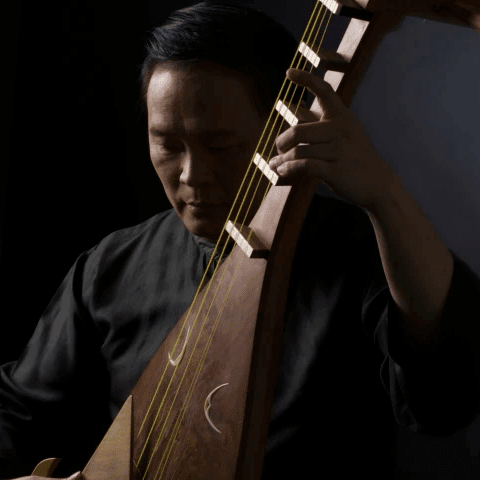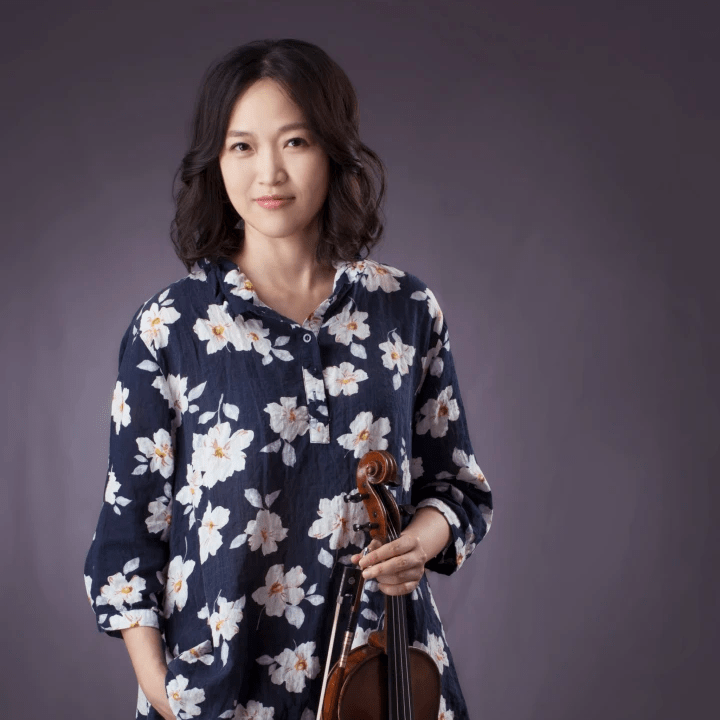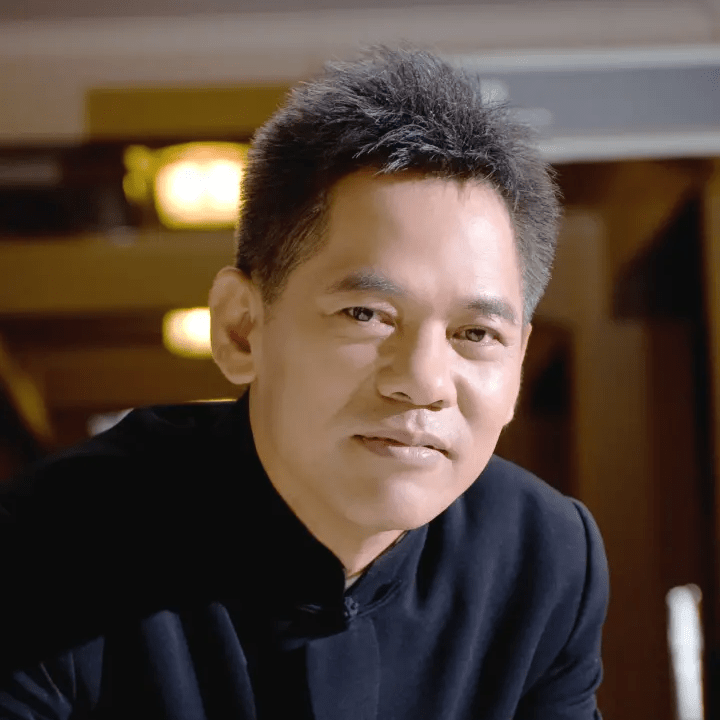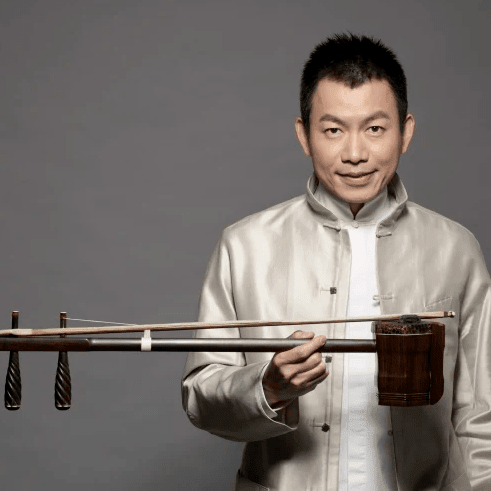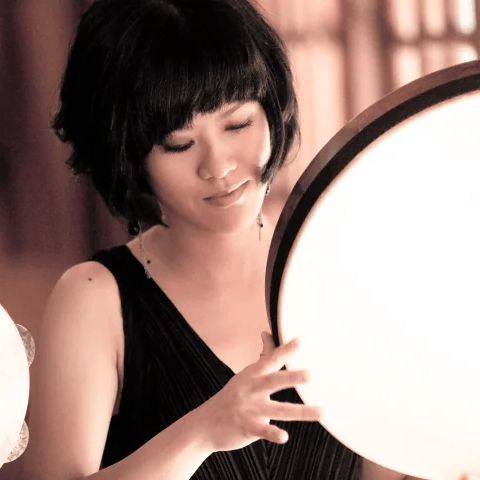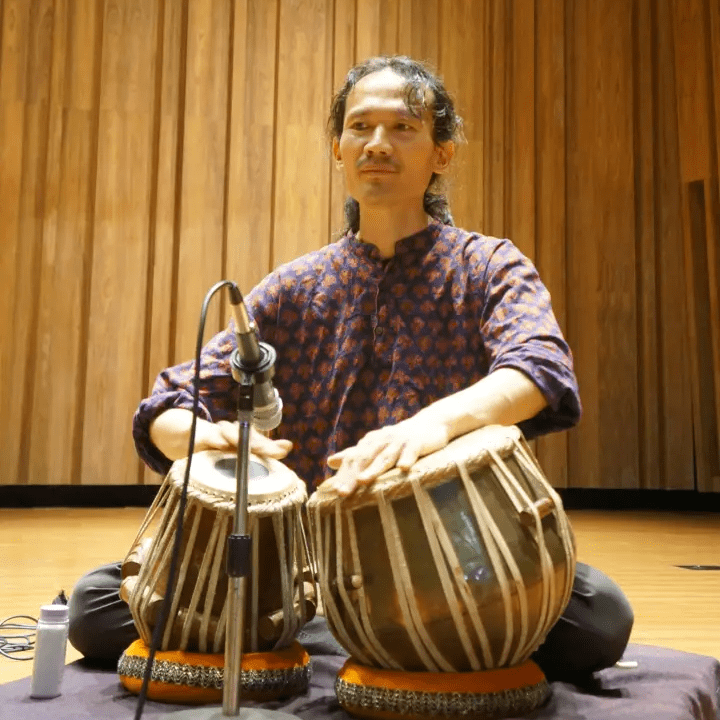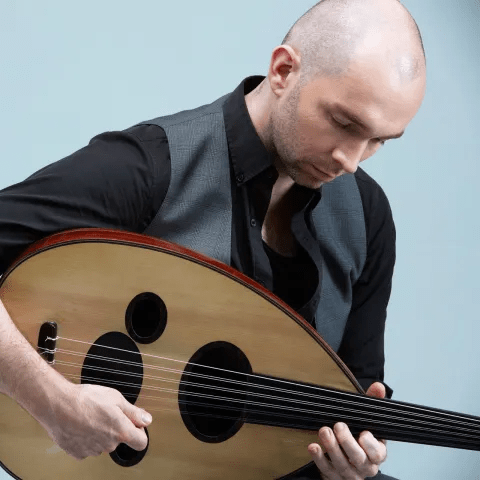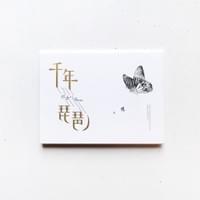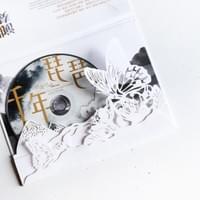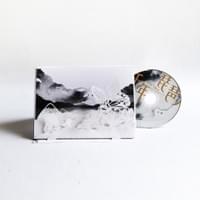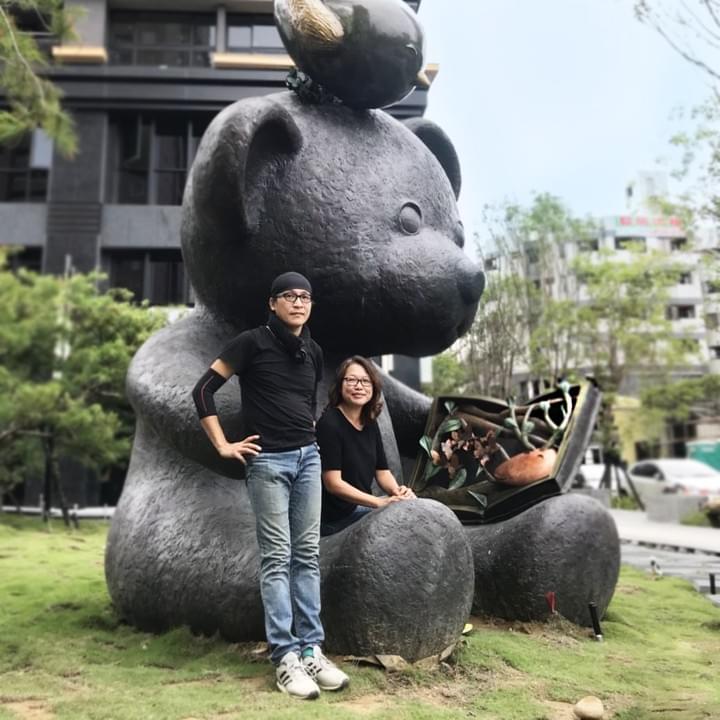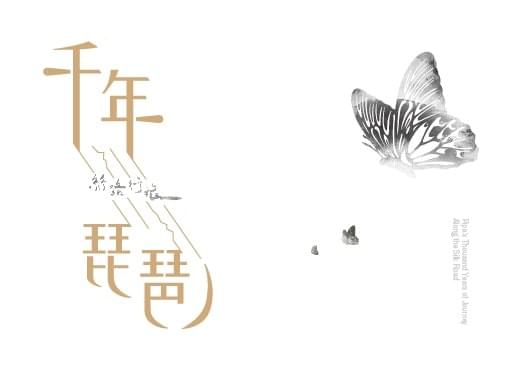



專輯緣起
Origin
穿越千年珠玉之聲、共享當代琵琶之美
A Sound for All Ages
自2007年...
Since 2007...
王世榮教授開始了「千年琵琶」文化尋根計劃,從琵琶的歷史沿革與傳承去尋找失落的傳統,探討現代琵琶教學法日漸流失的傳統演繹式口傳心授的核心價值。在時代潮流的衝擊下,民族音樂的文化傳承是全世界迫在眉梢的課題!現今所見到的琵琶皆源自於唐代曲項四弦四柱琵琶,直項五弦琵琶相關資料僅存於敦煌壁畫、陶俑、敦煌琵琶譜、天平琵琶譜、文獻紀錄。如何面對傳統與現代、繼往與開來的歷史演化,確保傳統民族音樂的一脈承襲,實為當務之急!
The Pipa Journey of A Thousand Years was begun in 2007 to retell the story and tradition of this classic Chinese instrument for a modern audience. The pipa, an instrument with a long and illustrious history, has been passed down from master to apprentice for generations. In this modern age, however, that tradition has begun to wane. But its decline is not indicative that the pipa is not relevant to our age. The models of pipa we see today can be traced back to the Tang dynasty, though not in the same form. It and other such instruments, precious remnants of our illustrious culture, are facing similar fates. What comes next is important—what role the pipa will play in this present world, how it will develop in the future, and how the folk culture it represents be imparted to the future generations?
當代琵琶大師劉德海...
The most respected master of the pipa in our time, Liu De-Hai,
劉德海大師在其「保護傳統文化遺產工程」《“1”行動計畫》備忘錄中寫道:「現階段,文化價值取向『商品化』、藝術生產『工業化』、文化消費『娛樂化』、整個社會『世俗化』等等現象給音樂家帶來極大衝擊和負面影響。中國地方民間音樂的植被已以驚人的速度日趨『荒漠化』。幾十年前,我們還可以充充裕裕、慢條斯理地向民間藝人學習,如今已落到『搶救活人』,甚至無人可『搶救』的窘地。歸根結底一切文化危機浮躁心態和盲目行為來自於自身的文化覺悟程度。搶救地方民間音樂首先搶救『自己』。一旦我們有了文化自覺和悟性,藝術財富就會在我們的面前出現。」
in the memorandum of Action 1 Initiative, a project to preserve precious cultural traditions wrote, “At the current stage, consumerist cultural values, industrialized artistic production, entertainment-oriented cultural consumerism, and a secularized society, among other such phenomena, have impacted and negatively influenced musicians. Folk musical traditions in areas of China, once flourishing, have become barren by the day. Just decades ago, we had ample time to learn from these rich, living traditions; now, we are scrambling to find living conduits of these traditions from certain death—some lack even living masters to learn from. To make the long story short, the bumbling mentality and blind actions associated with this cultural crisis are a result of the poor level of cultural awareness of our society. Saving local folk music starts with saving oneself. Once we are awakened to our culture, the artistic wealth of ancestry accumulated from hundreds of years of endeavor will be right there in front of our eyes.”
「千年琵琶」專輯的起造人...
The creator of this album, Chang Yi-Chen:
張宜蓁是「千年琵琶」專輯的起造人,2010年王世榮教授應張宜蓁的邀請,參與傳藝中心的跨界主題,策展「千年琵琶」專題音樂會,將王教授多年來的學習研究成果,編創一系列不同形制琵琶的經典作品,融合多元文化的音樂類型,讓「千年琵琶」專輯得有機會以跨界演奏的形式呈現於世。
In 2011, Taiwan’s renowned pipa master Wang Shi-Rong was invited by Taiwan’s National Center for Traditional Arts to present a concert series named “The Pipa Journey of A Thousand Years,” where a variety of pipa repertoire created from Wang’s vast research, through Chang’s compositional retouch and arrangement, were played, bringing together a diversity of cultural elements for the world to enjoy.
曲目介紹
Introducing the Music
跨越文化的對白、超越時空的綺響
A Dialogue Spanning Cultures And Times
覓蝶記 The Chasing of the Butterfly
編制:琵琶、高胡/二胡、中阮/大阮、鐵琴/中國與拉丁打擊、電子預錄音源
Composed for Pipa, Gaohu, Erhu, Zhongruan/Daruan, Vibraphone/Chinese and Latin Percussion, Pre-recorded Electronic Music
這首作品根據南管曲譜《百鳥歸巢》的樂曲架構與織度重新加以裁編、作為整首作品樂思的依據。全曲間或以傳統(南管對奏手法)、跨界(中、西樂器)、現代(電子音源與異國曲調、節奏元素) 的交互構成,來描述人生於虛實之間,在回憶與未來之中穿梭-永無止境的蝶之夢。
A rearrangement of the Nanguan tune “A Hundred Birds Returning to Nest,” which takes part in the musical structure, texture, and intent of the original, showcases the technique of heterophony from the Nanguan style, instruments from both East and West, musical elements from modern music, and foreign melodies and rhythms. This piece depicts life as lived between the worlds of the virtual and real, as visions of the past and presages of the future, as represented in the dream of a butterfly, recalling the Daoist philosopher Zhuangzi.
www.youtube.com/watch?v=VLs6Ba9w8ZI (搶先聽 short clip)
五四彈 Pluck the Four to Five
編制:薩摩琵琶/仿唐五絃琵琶、馬林巴琴/伊朗薩巴手鼓、人聲/小提琴
Composed for Satsuma Biwa/Tang Dynasty 5-String Pipa, Marimba/Iranian Zarb (Hand Drum), Vocal/Violin
這首作品以後現代手法來表現王世榮教授「千年琵琶系列研究專題」各種傳統經典的素材。作曲者嘗試將這些素材整編融會,是後拼貼與後集成 (post-patched/complied)的物件組合。所有的音調與節奏都建構在文化符碼之上,盡量讓每一段曲構都源自可辨識的文本。除了西方語法以外,共包含了鶴田流的唱腔與薩摩琵琶語法、敦煌琵琶譜、維吾爾木卡姆、波斯鼓語、巴爾幹與中東曲調節奏語法、印度循環節奏、還有屬於個人重新建構的調式與節奏等。
This piece presents, through modern techniques, many of the traditional elements from Wang Shi-Rong’s Pipa Journey of A Thousand Years research topic series. These elements are stitched together by the composer, post-patched and complied into final work. The tone and rhythm are imposed on a structure of cultural symbols, with each section coming from a recognizable text. While Western musical elements are present, it is not alone; it is accompanied by the vocal quality of the Tsuruta style and the musical techniques of the Satsuma Biwa, the Dunhuang pipa scores, the Uyghur muqam musical mode from Xinjiang, Persian drum literature, tune and rhythm from the Balkans and Middle East, Hindustani tala (rhythmic language of North India), as well as individually reconstructed modes and rhythms.
www.youtube.com/watch?v=zu9hwtVy-6I (搶先聽 short clip)
四月幻想曲 Fantasia for April
編制:越南月琴、烏德琴、中東鈴鼓/手鼓
Arranged for Đàn Nguyệt (Vietnamese Lute), Oud, Riq/Arabic Tabla
整首作品根據越南才子樂《南倒》作為原型來開展,越南月琴的節奏韻律與中東音樂的曲式與風格不謀而合地展現許多異曲同工之妙,以熱情的幻想曲風呈現跨文化交會的新意。
The prototype of this piece is based on “Nan Dao,” a classic song of the traditional music (Tài Tử) from Southern Vietnam. While the rhythmic scheme of the Vietnamese lute tune and the style of Middle Eastern music play on equal terms, this piece unfolds its natural characteristics of stylistic coherence though with the intercultural instrumentation that has only been put together for the first time. In the style of a fantasia, this piece presents a new idea of spontaneity in the mixing of theoretical modes, cultural idioms, and musical styles.
www.youtube.com/watch?v=eknCh7Jepx4 (搶先聽 short clip)
長相思 Longing Love
編制:越南琵琶、西塔琴
Arranged for Đàn Nguyệt (Vietnamese Pipa), Sitar
琵琶原作與北印度古典音樂風格的對話,在西塔琴根據拉格曲Raga 的即興手法間,交織出越南才子樂《長相思》 新翻演奏的美感與獨特風韻。越南琵琶與西塔琴水乳交融的情感,從平靜到激昂,帶領聽眾心領神會,進入跨越時空的音樂綺想。
This pipa piece engages in a dialogue with classical Northern Indian musical styles. The sitar playing in the improvisational framework of the Indian raga style alongside the Southern Vietnamese Tài Tử song “Longing” gives the listeners a completely new appeal to the senses. Sitar and pipa, each complimenting the other, shifting from serenity to excitement, move the piece into an almost spiritual experience for the listener, bringing them into a time-transcending vision.
www.youtube.com/watch?v=8pDVATykXbk (搶先聽 short clip)
梅花操 Plum Blossom
編制:南管琵琶、小提琴、塔不拉鼓
Arranged for Nanguan Pipa, Violin, Tabla
擷取南管曲譜《梅花操》精華片段作為結構基底,這首作品的前導部分意圖以類似巴洛克幻想曲風的裝飾奏曲思對應南管原曲,入板後,加入北印度古典音樂的節奏語言,轉化了小提琴的角色或聲響,使其發音類簫似管,並強調南管琵琶在音響色彩與手法上的另一種可能性。時空錯置的物件結構呈現了音樂在後現代主義指導下的一種表現方式。
Deriving its material from one particularly wonderful section of the original Nanguan score of “Plum Blossom,” this piece begins, in its prelude, by attempting the style of a Baroque fantasia as a resonance to this Nanguan classic. As the introduction section in slow tempo ends, the rhythmic language of classical Northern Indian music enters into the mix, transforming the character and sound of the violin to something approaching xiao, a Nanguan wind instrument. At the same time, it gives a certain sense of possibility to the color, tone, and technique of the Nanguan pipa. Structures outside of their proper time convey the methods of musical presentation in the postmodern era.
www.youtube.com/watch?v=9S23QnfcMgg (搶先聽 short clip)
認識演奏家
Meet the Musicians
菁英齊聚、經典樂饗
Creating the Moment of Eternity

王世榮 Wang, Shi-Rong
中國現代琵琶、薩摩琵琶、南管琵琶、仿唐琵琶、越南琵琶、越南月琴
Modern Chinese Pipa, Satsuma Biwa, Nanguan Pipa, Tang Dynasty Pipa, Đàn Tỳ Bà (Vietnamese Pipa), Đàn Nguyệt (Vietnamese Lute)
臺灣最富盛名的琵琶演奏家之一,經常與國內外知名民族管絃樂團、西洋交響樂團及室內樂團合作琵琶協奏曲及室內樂作品,演奏足跡遍及歐、亞、美三大洲。近年專注於探索琵琶形制的歷史沿革與器樂語法,多次赴大陸、日本、越南等地,針對所保存的琵琶現況進行田調及演奏技法學習,並與國內世界音樂名家合作系列「千年琵琶」專題音樂會,嘗試多元文化跨界的新視界。曾出版個人琵琶與管弦樂演奏專輯「封神榜」、琵琶演奏專輯「古苑尋聲」,獲第20屆金曲獎傳統音樂類「最佳專輯」。現專任於國立臺北藝術大學傳統音樂學系,為傳統音樂文化傳承盡一份心力。
A renowned pipaist dedicated to performance, education, and the preservation of musical traditions, Wang has appeared as a soloist for many ensembles and orchestras in Taiwan, Europe, Asia, and the US. He is also an enthusiastic chamber player. Aside from performances, Wang has dedicated himself to disseminating knowledge about this symbolic instrument of Chinese music. In recent years, this has meant investigating the history of the pipa and conducting field investigations of existing pipas and their players in China, Japan, and Vietnam. In the concert series The Pipa Journey of A Thousand Years, Wang experimented with diverse cultures and musical styles. Wang released a solo album for pipa The Tender Treasure of Ancient Musical Garden, for which he was awarded Best Album in the traditional music category of the 2009 Golden Melody Awards. He currently teaches at the Taipei National University of the Arts, Department of Traditional Music.

張宜蓁 Janelle Chang, Yi-Chen
作曲、編曲、小提琴、演唱
Composition, Arrangement, Violin, Vocal Performance
美國新英格蘭音樂院 New England Conservatory 當代即興演奏、小提琴演奏雙碩士,2017年起於該校攻讀作曲博士。專長古典、爵士、即興、世界音樂,演奏足跡包含臺灣、美國、加拿大、匈牙利、日本、中國大陸、印尼、泰國等地。曾赴新疆藝術研究所與首爾國立國樂院訪學、擔任華人最大線上音樂網 KKBOX 世界與心靈音樂單元主筆、並成立「東方世界音樂聯盟」,推廣東歐、中東、中亞、印度風格的絲路音樂。2011年獲傳藝金曲獎「最佳跨界音樂專輯」、入圍「最佳演奏獎」,2016年入圍流行金曲獎演奏類「最佳作曲人」。現為臺北市立國樂團及臺灣國樂團委託作曲家。
A graduate of the New England Conservatory with a dual Master's degree in improvisation and violin performance, and currently a composition major in the doctoral program, Chang is a specialist in classical, jazz, improvisational, as well as world music. She has concertized the world over, in such locales as Taiwan, the US, Canada, Hungary, Japan, Mainland China, Indonesia, and Thailand; and has been a visiting scholar at the Xinjiang Arts Institute in China and the National Gugak Center in Seoul, Korea. She is also a columnist whose works have been featured on the largest Chinese online music platform, KKBOX. As the founder of Oriental World Music Alliance, Chang promotes the musical traditions of the cultures along the Silk Road, the trade routes that once ran through the areas of Eastern Europe, the Middle East, Central Asia, and India. Her work was awarded the Best Crossover Album in the 2011 Golden Melody Awards for Traditional Arts and Music and was nominated for Best Performance; in the 2016 Golden Melody Awards, she was nominated for Best Instrumental Composition in the popular music category. She has been commissioned by the Taipei Chinese Orchestra and National Chinese Orchestra to present various works for Chinese orchestra, wind ensemble and chamber music since 2012.

吳瑞呈 Ray Wu, Rui-Cheng
指揮 Conducting
畢業於中國文化大學音樂系國樂組、並取得該校藝術碩士學位,曾任臺北市立國樂團副指揮、附設青年國樂團及市民國樂團指揮,另曾多次客席指揮臺灣揚琴樂團,並指揮該團與香港青少年國樂團於香港沙田大會堂演出。2014年指揮佛光山梵唄讚頌團於紅磡香港體育館演出「梵音香江 • 遍傳三千」梵唄音樂會。曾參與製作出版「河邊春夢—周添旺1930年代絕版流行歌專輯」,並為劉鳳學唐樂舞重建作品「團亂旋」、「傾盃樂」擔任編曲。近年主要作品有「雲州追想」、「金石堂」等十餘首。
A graduate of Chinese Culture University with a Master of Arts in Chinese music, Wu was the associate conductor of the Taipei Chinese Orchestra (TCO) and principal conductor for the Senior Youth Orchestra and Civic Orchestra, both sub-orchestras under the TCO. He has been the guest conductor for the Taiwan Yang-Qin Ensemble on several occasions, one of which with the Hong Kong Junior Chinese Orchestra at Hong Kong’s Sha Tin Town Hall. In 2014, he conducted the Fo Guang Shan Buddhist Monastic Choir in a Buddhist prayer concert at the Hong Kong Coliseum. He has participated in the recording of several albums, including A Springtime Dream on the Riverside—an Album of the Out-of-Print Popular Music of Chiu Thiam-ōng from the 1930s, and has arranged for works from Tang Music and Dance, including “Whirl Around” and “The Joy of Drinking a Toast.” His more recent works include “Cloud City Recollections” and “Jin Shi Tang,” among others.

王銘裕 Wang, Ming-yu
二胡、高胡 Erhu, Gaohu
畢業於中國文化大學音樂系國樂組,並取得該校藝術碩士學位。現任臺北市立國樂團樂團首席,演奏足跡遍佈歐、亞、美、非、澳五大洲近三十國,曾於雪梨歌劇院、北京國家大劇院、巴黎夏特雷劇院、東京歌劇院等國際知名音樂殿堂演出。2009年出版二胡演奏專輯「思想起 – 王銘裕雋永的胡琴詩篇」。王君樂如其人,演奏細膩而深刻,優雅而謙沖,獲得極高評價。所使用的二胡已獲邀典藏於江蘇徐州—世界首座以胡琴為主題的「中國胡琴藝術博物館」。
A graduate of Chinese Culture University with a Master of Arts in Chinese music, Wang is currently the concertmaster of the Taipei Chinese Orchestra. As one of the most acclaimed erhuists of our time, Wang has concertized in the five major continents: Europe, Asia, the Americas, Africa, and Australia, totaling nearly 30 countries. This includes such famous performing venues as the Sydney Opera House, Beijing's National Centre for the Performing Arts, Paris' Théâtre du Châtelet, and Tokyo Opera City. In 2009, he released a solo erhu album Ming-yu Wang's Beautiful Moment with Erhu. The fine, deep quality of his performance has met with wide acceptance—even to the extent that an erhu he has performed on is kept in the Erhu Art Museum, the first Chinese bowed-instrument museum in the world.

陳怡蒨 Chen, Yi-Chien
中阮、大阮
Zhongruan, Daruan (Chinese Lute)
國立臺南藝術大學中國音樂學系專任副教授,當代藝林樂集藝術總監。曾任香港中樂團柳琴助理首席、文化大學中國音樂系與南華大學民族音樂系柳琴、阮咸兼任講師、臺北柳琴室內樂團首席。畢業於中國文化大學音樂系國樂組,並取得該校藝術碩士學位。2008年以「絲竹空」專輯入圍流行金曲獎「最佳演奏專輯」,2016年入圍傳藝金曲獎「最佳創作獎」。著有柳琴獨奏、合奏及重奏創作曲「秋」、「天黑黑隨想曲」等十多首作品。
A graduate of Chinese Culture University with a Master of Arts in Chinese music, Chen is currently an assistant professor at the Tainan National University of the Arts and artistic director of the Contemporary Artists Ensemble; her glamorous posts include principle liuqinist for the Hong Kong Chinese Orchestra, instructor in liuqin and ruan at the Chinese Culture University and Nanhua University, and director of the Taipei Liuqin Chamber Orchestra. One of her ensemble albums, Sizhukong, was nominated for Best Album in the Instrumental category of the 2008 Golden Melody Award; she was again nominated in 2016 for Best Original Work. Chen’s works include “Autumn” and “The Sky is Dark Caprice,” among other works for solo liuqin and ensemble.

鄭雅心 Cheng, Ya-Hsin
鍵盤打擊、鼓類打擊
Keyboard Percussions (Marimba and Vibrophone), Drums
國立臺灣師範大學音樂系畢業,2007年於法國里昂國立高等音樂院,獲打擊樂演奏文憑第一獎暨全體裁判一致通過獎畢業。2005年榮獲法國 Claude Giot 國際鐵琴大賽銅牌,2009年盧森堡國際擊樂二重奏大賽銅獎。2009年與張育瑛共創NanaFormosa 擊樂二重奏,演出遍及盧森堡、法國、中國大陸、日本、臺灣、美國等。2014年發行首張鍵盤擊樂二重奏專輯「謐光 Lueur」。現為國立臺灣師大、臺南藝術大學、中山大學等校音樂系及台北中正高中音樂班、舞蹈班兼任擊樂助理教授。
演奏家個人網站 http://www.nanaformosa.com/
A graduate from National Taiwan Normal University, Cheng studied at the Conservatoire national supérieur musique et danse de Lyon and graduated with the highest honors diploma in 2007. In 2005, Cheng was awarded bronze in the Claude Giot International Vibraphone Competition in France and in 2009 she was awarded bronze in the Duet section of the International Percussion Competition Luxembourg. In 2009, NanaFormosa, a duo co-founded by Cheng, toured the world, playing in Luxembourg, France, Mainland China, Japan, Taiwan, and the US, among other locales. Her first duet album for percussion, Lueur, was released in 2014. She is currently an assistant professor of percussion at National Taiwan Normal University, Tainan National University of the Arts, and National Sun Yat-Sen University.

若池敏弘 Toshihiro Wakaike
塔不拉鼓 Tabla
日籍塔不拉鼓演奏家。演奏足跡遍及印度、孟加拉、日本、台灣、泰國、韓國、中國大陸、加拿大等。目前活躍於台灣樂壇,擔任過國立臺南藝術大學、臺北藝術大學、臺灣大學印度音樂工作坊導師及臺灣塔不拉鼓愛好會會長。演出甚為頻繁,曾在身聲演繹劇場、台中爵士音樂節、第四十五屆廣播金鐘獎等音樂會場演出。其作品曾於2011年獲傳藝金曲獎「最佳跨界音樂專輯」得主、「最佳演奏獎」入圍。
Hindustani music expert in tabla and esraj from Japan, Toshihiro has played in several locations throughout the world, including India, Bangladesh, Japan, Taiwan, Thailand, Mainland China, and Canada. His previous posts include instructor at the Tainan National University of the Arts and the Indian Music Workshop at National Taiwan University; he is currently active in the Taiwanese music scene. An avid performer, Toshihiro has played at the Sun Son Theatre, Taichung Jazz Festival, and the 45th Golden Bell Awards. Recording works by Toshihiro have been awarded Best Crossover Album and nominated for Best Performance at the 2011 Golden Melody Awards for Traditional Arts and Music.

金光亮平 Ryohei Kanemitsu
西塔琴 Sitar
日籍西塔琴演奏家,印度西塔琴巨匠 UstadShujaat Khan 嫡傳弟子。2013年在臺北國家音樂廳與臺北市立國樂團共同演出,並赴英國演出。2014年在國家戲劇院和人力飛行劇團共同演出,並於第十八屆國家文藝獎頒獎典禮演出,2016年受邀於愛丁堡國際藝穗節“臺灣季 Taiwan Season ”演出。成立 Wooonta 跨界樂團,首張專輯 “Wooontaful” 於2017年入圍傳藝金曲獎「最佳跨界音樂專輯」與「最佳創作獎:編曲 」。目前 Wooonta 為塔拉那現場藝術合作樂團。
演奏家個人網站 https://www.sitaryo.com/
Acclaimed sitarist from Japan, Kanemitsu has studied under sitar legend Ustad Shujaat khan. He has performed at such prestigious venues as the National Concert Hall in Taipei in 2013 with Taipei Chinese Orchestra. In 2014 he performed with Mr. Wing Theatre Company at the National Concert Hall; he also performed at the 18th National Award for Arts in the same year. In 2016 he was invited to the Edinburgh Festival Fringe, where he performed “Taiwan Season.” Kanemitsu is the founder of Wooonta, a crossover band, whose album Wooontaful was nominated for Best Crossover Album and Best Composition: Arrangement at the 2017 Golden Melody Awards; the band collaborates with Tarana Live, a Kathak dance group in a regular basis.

Alban Couëffé
烏德琴 Oud
法籍烏德琴演奏家,1989年開始於法國里昂國立音樂學院修習小提琴,為該校青少年樂團首席。因受到父親的啓蒙而學習烏德琴。2008至2009年與南管歌手吳欣霏合作錄製唱片,並與金貝鼓大師 Drissa 舉行演奏會。目前定居於臺灣,為知名跨界爵士樂團「Bazaar 中東爵士」烏德琴手。2018年獲流行金曲獎演奏類「最佳專輯」入圍、2016年金音獎 「最佳樂手」得主、「最佳爵士專輯」入圍。
A multi-instrumentalist from France specialized in oud and many other instruments, Couëffé began his music study of the violin in 1989 at the Conservatoire national supérieur musique et danse de Lyon, where he was the concertmaster of the school’s youth orchestra. From 2008 to 2009, he collaborated on a record with the Nanguan singer Wu Xin-Fei, and in a concert with djembe master Drissa Kone. Currently, Couëffé is the oudist for the Bazaar Mideast Jazz group. He was awarded Best Musician and the group’s album was nominated for Best Jazz Album in the 2016 Golden Indie Music Awards; their second album was also nominated for Best Album in the 2018 Golden Melody Awards.

April Centrone
中東手鼓、鈴鼓 Darbuka, Tambourine
美籍青年中東鼓演奏家、黎巴嫩鼓樂大師 Michel Mirhej Baklouk 嫡傳弟子、 紐約阿拉伯管弦樂團執行總監、中東音樂大師 ZiadRahbani 樂團首席鼓手、中東簫與烏德琴大師 Bassam Saba 長期合作樂手。演奏經歷遍及歐、美、亞三大洲,曾受邀於美國卡內基音樂廳、林肯中心演出。在繁忙的演奏事業之餘,也致力於將打擊樂使用於專業心理治療的研究。目前定居於紐約與貝魯特兩地,並從事黎巴嫩境內中東難民兒童的音樂教育與心理治療工作。
演奏家個人網站 http://www.aprildrums.com/
American multi-instrumentalist Centrone is considered as one of the best world music women percussionists of our time. Specialized in Middle Eastern music, she studied tabla and riq with Lebanese/Palestinian legend percussionist Michel Baklouk Merhej. Centrone is also the co-founder of the New York Arabic Orchestra, head percussionist for the Ziad Rahbani Band and Orchestra, and a long-term collaborator with the world’s renowned oudist and nayist Bassam Saba. Centrone has concertized in Europe, the Americas, and Asia, and has played at New York City’s Carnegie Hall and the Lincoln Center. Outside of performing, she has taken her percussion and music into therapy research. She currently lives in New York and Beirut, and devotes her time and care to providing music education and therapy to the youth of refugee camps throughout Lebanon.
http://www.aprildrums.com/
- 琵琶綜覽An Overview of the Pipa亙古不朽、薪傳永存An Instrument With A Rich and Varied History
仿唐直項五弦琵琶
Tang Dynasty Long-Necked 5-String Pipa

琵琶形制的歷史沿革,主要可分直項五弦與曲項四弦兩種形制。曲項琵琶源自於烏德琴,弦槽部位呈約九十度上揚彎曲,有別於直項的直頸。五弦琵琶在印度原為直項、手彈,傳到中國時可能經龜茲地方,在「龜茲樂」與曲項四弦琵琶一起演奏又產生了變異,所以後來在中原地區有的五弦琵琶用撥彈,有的用手彈。在趙璞的《中國樂器學琵琶篇》提到:「唐朝以前的五弦琵琶,在古文獻中的記載並不詳細。而惟可考的有兩件隋、 唐遺存的五弦琵琶:一件是隋朝流傳到韓國 (朝鮮) 現仍保存完整的五弦琵琶「鄉琵琶」(圖1);另一件則是日本奈良正倉院珍藏的唐朝傳到日本的螺鈿紫檀五弦琵琶」(圖2)。
Pipas can be categorized into those with a straight neck and those with a curved neck: curved-neck pipas derive from the oud and have a 90-degree bend at the neck near the nut of the headstock, whereas the neck of the straight-necked pipa is not curved. The Indian 5-stringed pipa was originally straight-necked, hand-plucked; some changes may have been introduced by its encounter with the four-stringed curved-neck pipas in the ancient kingdom of Kucha—this may be the reason there are plectrum-picked and finger-picked pipas in the Central Plains of China.
Picture 1 on the left as below: the 5-string Korean hyangbipa, introduced to Korea during China’s Sui dynasty.
Picture 2 on the right as below: The 5-string inlaid rosewood pipa made in the Tang dynasty (now preserved at Shoso-in Treasure Repository in Nara, Japan).

從持琴角度來分析:横抱(偏下斜)對於實際彈奏的感受是最放鬆、也最合乎人體工學,也利於撥彈角度。唐朝詩人白居易對於唐朝頗負盛名的五弦琵琶演奏大師趙壁的演奏藝術,在他的詩作《五弦》裡贊歎寫道:清歌且罢唱,紅袂亦停舞。
趙叟抱五弦,婉轉當胸撫。
大聲初若散,颯颯風和雨。
小聲細欲絕,切切鬼神語。
又如鵲報喜,轉作猿啼苦。
十指無定音,顛倒宮徵羽。
坐客聞此聲,形神若無主。
行客聞此聲,駐足不能舉。
嗟嗟俗人耳,如今不好古。
所以綠窗琴,日日生塵土。
趙壁的五弦琵琶演奏藝術超凡絕倫,「此曲只應天上有,人間難得幾回聞」。
The grip on the instrument is also important: horizontal (slightly diagonal) positioning is the most ergonomic and relaxed, and better positioned for strumming.
據《新唐書》記載十部伎之其中八部使用了從西域傳來的琵琶與五弦,在大同雲崗石窟雕像中,常見曲項四弦琵琶與直項五弦琵琶並列演奏 (圖3),可見在隋唐燕樂中五弦琵琶發展的盛況。
It is recorded in the New Book of Tang that the pipa and the five-string, both from the Western Regions (modern-day Xinjiang and beyond), were in use in China at that time. And viewers can see four-stringed, curved-neck pipas playing alongside five-stringed, straight-neck pipas in stone carvings at the Yungang Grottoes, giving some idea as to the development of the five-stringed pipa in court music. (picture 3)

日本薩摩琵琶
Japanese Satsuma Biwa

7世紀之後傳入日本的琵琶有兩種:(一)雅樂中使用的樂琵琶、(二)盲僧誦經時伴奏用的盲僧琵琶。至12世紀再由樂琵琶發展出平家琵琶,盲僧琵琶在16世紀發展形成了薩摩琵琶,到了19世紀產生了筑前琵琶。日本正倉院至今仍保存被視為有形文化遺產的中國唐代五弦琵琶、四弦琵琶及圓形的阮咸實物,是考據日本琵琶淵源最明確的實證。
When the pipa entered Japan in the 7th Century, it was generally in two versions: (1) the gaku-biwa, used at the imperial court, and (2) the mōsō-biwa, used in religious rites by blind monks. The gaku-biwa evolved into the heike-biwa in the 12th Century, while the mōsō-biwa became the Satsuma biwa in the 16th Century and the Chikuzen biwa in the 19th.
2008年赴日拜鶴田流薩摩琵琶大師田中錦煌老師學習,田中老師是鶴田流宗師鶴田錦史的弟子。傳統薩摩琵琶主要是自彈自唱的方式,少有純器樂演奏的傳統薩摩琵琶曲目。薩摩琵琶的持琴姿勢有別於雅樂琵琶的橫抱,因薩摩琵琶的柱位音程間距擴大,左手需移動把位,勢必得採豎抱方便左手換把需求。右手木撥 (圖1) 的演奏技法不僅色彩豐富,撼動人心的爆發力,令人讚嘆!彈奏時,主要藉助木撥本身的面積與重量,搧動木撥擊弦發聲。絲弦的特性,表現強奏或快速音群時毫不費力,比指彈系統演奏法毫不遜色。
Traditionally, the Satsuma biwa is rarely played purely for instrumental music but is almost always accompanied by singing. The Satsuma also differs from the gaku-biwa in the grip; it’s being held vertically due to the larger intervals between the ledges. The right-hand plectrum technique, mainly using the area and weight of the plectrum, produces a richly colored sound that is extremely moving, and silk strings allow for easier emphasis and quick tone clusters; overall, plectrum-picking produces a satisfying sound of its own.

南管琵琶
Nanguan Pipa

南管是我國文化歷史悠久的民間樂種,從《韓熙載夜宴圖》(圖1) 中之伎女斜抱著梨形曲項琵琶,右手採撥彈、左手拇指按弦等,與南管琵琶之形制、持琴姿勢及左手扣弦指形非常神似。南管琵琶保留唐代形制,長二尺八寸、琴體呈梨形、鳳尾琴頭、窄頸、四相九或十品、品兩側有月眉形音孔,背板多為松木挖空,面板材質多為梧桐。所用琴絃以絲弦為主,但由於絲絃易斷,常以尼龍或尼龍混絲的特多龍材質琴絃。從南管琵琶的琴體、形制、持琴、學者研究論述及文獻記載等,可見其與唐宋之淵源。
The Nanguan pipa has a long tradition in Taiwan. In the painting Night Revels of Han Xizai (picture 1), female musicians are seen holding pear-shaped pipas diagonally, strumming with their right hand and holding down the frets with the left thumb—all these features point to the Nanguan pipa as the instrument depicted. The Nanguan pipa retains the shape of the Tang dynasty pipa: it is 85 cm in length, has a pear-shaped body, fern-shaped head, narrow neck, 4 ledges and 9 or 10 frets, moon-shaped sound boxes to the sides of the frets, a backboard of hollowed-out pine, and a face that is often made of Paulownia wood. The strings are primarily made of silk, though since silk is prone to breaking, today, strings are often made from nylon or a silk-nylon mix like Tetoron.
彈奏點挑(右手基本指法)時,手腕必須放鬆,力度隨著音樂的跌宕起伏呈現剛柔並濟之神韵,攆指速度變化微妙呼應腔韵氣口控制與音樂張力,右手姆指甲線之厚實勁道,亮如洪鐘。可見扎實的點挑基本功,是考驗南管琵琶技法火侯的試金石。辭雅韻美之中原古樂,看似簡易的琵琶指法卻蘊含如此深邃的審美思維,令人讚嘆。
When finger-picking the strings (tan-tiao, the basic fingering method with the right hand), the wrist must remain loose, and the force of the playing should vary in strength or softness according to the rhythm and undulations of the music. The speed of the finger-picking very subtly follows the movement of the breath and tension of the music, while the forceful right thumb creates a resounding sound. Such a demanding instrument tests the skills of many pipa players.

越南琵琶

中國明朝的宮廷音樂於黎朝初期 (1428-1789) 至阮朝中葉 (1802-1945) 有系統地輸入越南,這一時期形成的越南宮廷音樂有:雅樂、小樂、細樂、韶樂、女樂等。但越南也不是全盤接納中國明朝宮廷音樂,歷經200百年的消化觸變,至19世紀初已經展現出越南化特色的文化風貌。越南雅樂於2003年獲聯合國教科文組織 ( UNESCO ) 列入「人類口頭與非物質文化遺產」。越南河內國家音樂學院教授武氏梅芳 (也是知名越南琵琶演奏家) 在她的碩士論文《越南傳統音樂的琵琶》中寫到:從李朝 (1010-1225) 開始,越南音樂已經出現明顯的分化,成為兩部分:宮廷音樂和民間音樂,同時也出現新的樂器。李朝時,下列幾種樂器使用非常普遍:陶塤、板、胡琴、笛、古琴、琵琶、饒鈸和蕭。從中我們可以看到,琵琶在越南舞台上也已經佔有一席之地。
Court music from Ming China entered into the Vietnamese courts of the Le dynasty (1428-1789) and the Nguyễn dynasty (1802-1945) and formed Vietnamese-specific court music forms: Nhã nhạc, Tiếu nhạc, Thiều nhạc, and Nữ nhạc. However, the Vietnamese court did not merely use Chinese court music: they made it their own after 200 years of fine-tuning, giving it a distinctly Vietnamese style and feel. In 2003, Nhã nhạc was entered into the UNESCO intangible cultural heritage in the oral traditions and expressions category.
「傳統越南琵琶」(圖1):主要承襲中國明朝琵琶之四相十品形制,其四相是依近十二平均律的半音音程排列,品位依近七律排列,四相琵琶在1975年戰後時期才正式地退休被高品所取代」,即原本那四相被依七律排列的三個高品取而代之,稱之為「改進琵琶」(圖2)。琴體內裝有固定銅片,加強音色共鳴,現今製琴師已少用,前輩認為銅片象徵著樂器的「心」,意喻「樂自心中來」。
The Vietnamese adaptation of Chinese court music mainly uses the 4-ledge, 10-fret pipa from Ming China; the four ledges adopt the half-step interval of twelve-tone equal temperament and frets are approximately seven-tone equal temperament (picture 1). The four-ledged pipa lasted until 1975 when it was replaced by three high frets in seven-tone equal temperament—this pipa is known as the “advanced pipa” (picture 2). The inner body of the pipa is fitted with a bronze plate to increase the resonance of the instrument. Though rarely is this technique applied today, Craftsmen of these instruments believe that the bronze plate represents the heart of the instrument, quipping that “its music comes from the heart.”

在越南田調工作期間,當地學者及演奏家傳達的訊息:民間藝人的音感認知只有七音律 (或接近七全音) 的概念,並沒有西洋十二平均律大小調系統。在品相固定的琵琶上,透過七平均律的排品形制,尼龍琴弦張力較鬆,利於左手按壓揉弦技法,對於樂曲音律進行二度創造,產生一音多韵的音律詮釋,這樣的活性思維,方能體現越南傳統音樂的精髓。
It has been reported by scholars and performers in Vietnam that local artists only knew of the 7-tone (or approximate) equal temperament and did not know of the Western 12-tone equal temperament major/minor system. On the 7-tone equal temperament pipa, nylon strings are more lax, allowing the player to perform left-hand vibrato more easily, which gives a second mode of tuning for the music and giving additional interpretive space to each note. It is specifically this type of living mode of thought that can bring out the most refined essence of traditional Vietnamese music.
越南月琴
Đàn nguyệt

月琴在越南南部稱為掐琴( Đờn kìm ),在中部和北部被稱為月琴( Đàn nguyệt )。越南月琴有兩種形制:一、短頸月琴,由中國引進,四弦四軸, 8個低品,琴身短,品距窄,左手按壓困難。二、長柄月琴,將短頸月琴8個品改為高品,利於演奏滑音、按壓、揉弦,音色深沉。琴體內裝有固定銅片,加強音色共鳴,現今製琴師已少用,前輩認為銅片象徵著樂器的「心」,意喻「樂自心中來」。
The Đàn Nguyệt, or Vietnamese “moon” lute, comes in two styles: (1) the short-necked Đàn Nguyệt, which was brought to Vietnam from China, has four strings and four tuning pegs, eight low frets, a short body, narrow gaps between frets, and is notoriously difficult in pressing down strings with the left hand; and (2) the long-handled Đàn Nguyệt, which replaces the shorter version’s 8 low frets with high frets, which allows for easier slides, presses, vibratos, and deeper tones. The inner body of the Đàn Nguyệt is fitted with a bronze plate to increase the resonance of the instrument. Though rarely is this technique applied today, Craftsmen of these instruments believe that the bronze plate represents the heart of the instrument, quipping that “its music comes from the heart.”
「才子樂」為越南南部特有的一種娛樂音樂型態,取材自民間音樂、南部禮樂與順化宮廷音樂中的順化歌( Ca Huế ),並融入了越南傳統音樂的特色與越南南部方言,是一種適應力及包容性強大的樂種。「千年琵琶」專輯中的《四月幻想》,素材是「才子樂」的經典曲目三南(組曲:南哀、南春、南倒)之南倒。「才子樂」在越南傳統音樂與文化中佔有重要地位,是越南的寶貴遺產之一。(參考資料:越南「才子樂」的傳統與變遷 9/2015王依雯)
The traditional music of Southern Vietnam (Tài Tử) draws much of its content from folk music, southern ritualistic music, and traditional court music of Vietnam (Ca Huế). It also incorporates traditional Vietnamese music and its southern dialect; it is an extremely adaptive and tolerant mode of music. “Fantasia for April” on this album takes “Nan Dao,” a song of the traditional music of Southern Vietnam (Tài Tử), as its base. Tài Tử holds an important place in Vietnamese musical culture and is one of its precious cultural heritages.
中國琵琶
Chinese Pipa

現今所見到的琵琶皆源自於唐代曲項四弦四柱琵琶,其形制歷史沿革概況如下:
- 形制:梨形曲項四弦。
- 持琴:由左下方斜抱、平行橫抱、左上方斜抱到豎抱。
- 品制:由唐代的四~七柱、明代的十三柱、清代的四相九~十品 (即十三~十四柱)、20世紀初,在舊七品與第八品之間加入一個半音品,以十二平均律排列品相的四相十三品、20世紀40年代後品相增為四相十八~十九品、到了20世紀60年代出現以十二平均律半音排列品相的六相二十四~二十五品至今。
- 奏法:由撥彈到指彈。
- 弦制:由絲弦、鋼絲尼龍弦、到鋼絲弦。
Basically all pipas seen today are the descendants of the Tang dynasty 4-stringed, 4-ledged pipa. The evolution of the pipa from then to today is given below:
- Shape: Pear-shaped, four-stringed
- Grip: Diagonally from lower left, parallel horizontal, diagonally from upper left, vertically
- Frets: Tang dynasty (4-7), Ming dynasty (13), Qing dynasty (4 ledges, 9-10 frets; equiv. to 13-14 frets); Early 20th Century: added half fret between 7th and 8th, with 4 ledges, 13 frets, 12-tone equal temperament; post-1940s: increase to 18 – 19 frets; 1960s to present: 6 ledges, 14 – 15 frets, 12-tone equal temperament.
- Playing method: plectrum or finger-picking
- String material: Silk, steel thread nylon, steel
從上述,我們看到一千多年來琵琶在形制的歷史沿革,以此為起點,嘗試探討其演奏方法、音樂型態及文化價值,自2007年開始「千年琵琶」的文化尋根之旅。
Thus, in so many words, we have passed through a thousand years of evolution of the pipa, in aspects of performance method, musical quality, and cultural value. Thus has begun our exploration; thus begins our Pipa Journey.
設計理念 Album Design
以一首「覓蝶記」化開序幕,與一翦蝶影進入神秘曲境在東方水墨與現代設計手法交織之下就像千年絲路一般,帶領你走過沙漠,越過山丘穿越綿延不絕的琵琶樂音中 Modeled after “The Chasing of the Butterfly,” The album cover art depicts the contour of a butterfly in the epigrammatic mode of Chinese ink wash paintingAs it flutters within a mysterious realmLeading you along long-lost pathsWhere the lilting sounds of the pipa still resonate.
設計團隊
Design Team
由不同領域的專業夥伴 打造穿越千年的絕美專輯

蕭明瑜 Ming Yu, Hisao
現任ZAMAMA金屬工作室總監 大視設計總監 朝陽科技大學副教授
ZAMAMA大視設計以展現當代金屬工藝特質的產品為主,包括:銀飾、銅器、錫器、鋁合金染色容器與飾品等作品或公共空間裝置類金工作品。將舊材料透過創作手法而賦予物件新風貌,或擷取在地傳統文化元素再定義而呈現文化創意的內涵。
ZAMAMA品牌網頁:http://zamama.wix.com/zamama
大視設計品牌網頁:http://marktaiwan2002.wixsite.com/marktaiwan

賴璟葶 Miki Lai
現任FERN ONLY只有蕨生活家飾 品牌經理
FERN ONLY以呈現植物的細膩質感為主題,搭配東方水墨以及虛實意境之元素;不論是共食的餐桌,睡前的臥房,辦公時的桌面,皆能營造出蕨類植物獨特的居家氛圍,享蕨美的生活品味。
FERNONLY品牌網頁:https://www.facebook.com/fernonly2018/
經典鉅獻 公益傳承
聽音樂 做公益
A Priceless Musical Gift for Years to Come

台中市音樂發展協會年度鉅獻
聽音樂。做公益
每遞出一張《千年琵琶-絲路行旅》專輯,
您的愛心便化為發展台灣傳統與藝術音樂的一份力量
本專輯未在市面上販售,歡迎愛樂者與本會聯絡。 This recording is available by order only. Please contact Taichung Music Development Association for further information. All the income will be used for non-profit events.
電子信箱:tmdaservice@gmail.com
聯絡電話:(04)25272813
傳真電話:(04)25256222
三信商業銀行:(147)14-2-1332282
郵政劃撥帳號:22632306
戶名 (account):台中市音樂發展協會
地址 (address):臺中市豐原區豐東路85巷7號

張宜蓁的「玩樂」世界
Janelle Chang's Music Insight
歡迎欣賞我的音樂創作!
Welcome to My Youtube Channel
音樂無國界的定義是文化的、不是隨心所欲的。唯有深刻的同理心促使音樂的創作站在謙卑的基石之上,與人心對話。
What defines the boundless power of music is culture, not any free-minded individual. It is a deep understanding with empathy that makes a music creation, grounded in humbleness, speak to the hearts and minds of mankind.



